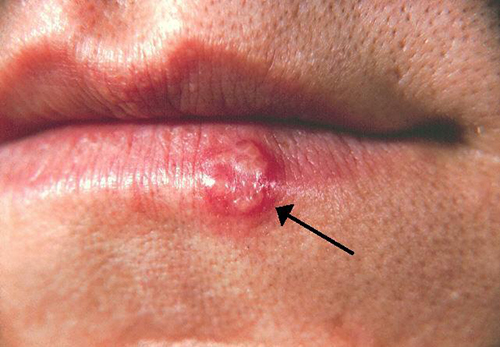| << Chapter < Page | Chapter >> Page > |
Infection by HSV-1 commonly manifests as cold sores or fever blisters, usually on or around the lips ( [link] ). HSV-1 is highly contagious, with some studies suggesting that up to 65% of the US population is infected; however, many infected individuals are asymptomatic. Wald, A., and Corey, L. “Persistence in the Population: Epidemiology, Transmission.” In: A. Arvin, G. Campadelli-Fiume, E. Mocarski et al. Human Herpesviruses: Biology, Therapy, and Immunoprophylaxis . Cambridge: Cambridge University Press, 2007. http://www.ncbi.nlm.nih.gov/books/NBK47447/. Accessed Sept 14, 2016. Moreover, the virus can be latent for long periods, residing in the trigeminal nerve ganglia between recurring bouts of symptoms. Recurrence can be triggered by stress or environmental conditions (systemic or affecting the skin). When lesions are present, they may blister, break open, and crust. The virus can be spread through direct contact, even when a patient is asymptomatic.
While the lips, mouth, and face are the most common sites for HSV-1 infections, lesions can spread to other areas of the body. Wrestlers and other athletes involved in contact sports may develop lesions on the neck, shoulders, and trunk. This condition is often called herpes gladiatorum . Herpes lesions that develop on the fingers are often called herpetic whitlow .
HSV-1 infections are commonly diagnosed from their appearance, although laboratory testing can confirm the diagnosis. There is no cure, but antiviral medications such as acyclovir , penciclovir , famciclovir , and valacyclovir are used to reduce symptoms and risk of transmission. Topical medications, such as creams with n -docosanol and penciclovir , can also be used to reduce symptoms such as itching, burning, and tingling.

The viral diseases roseola and fifth disease are somewhat similar in terms of their presentation, but they are caused by different viruses. Roseola, sometimes called roseola infantum or exanthem subitum (“sudden rash”), is a mild viral infection usually caused by human herpesvirus -6 (HHV-6) and occasionally by HHV-7. It is spread via direct contact with the saliva or respiratory secretions of an infected individual, often through droplet aerosols. Roseola is very common in children, with symptoms including a runny nose, a sore throat, and a cough, along with (or followed by) a high fever (39.4 ºC). About three to five days after the fever subsides, a rash may begin to appear on the chest and abdomen. The rash, which does not cause discomfort, initially forms characteristic macules that are flat or papules that are firm and slightly raised; some macules or papules may be surrounded by a white ring. The rash may eventually spread to the neck and arms, and sometimes continues to spread to the face and legs. The diagnosis is generally made based upon observation of the symptoms. However, it is possible to perform serological tests to confirm the diagnosis. While treatment may be recommended to control the fever, the disease usually resolves without treatment within a week after the fever develops. For individuals at particular risk, such as those who are immunocompromised, the antiviral medication ganciclovir may be used.

Notification Switch
Would you like to follow the 'Microbiology' conversation and receive update notifications?